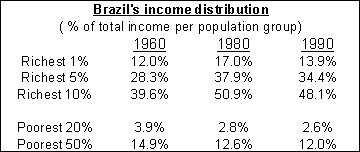
Source: IBGE.
Instituto Cultural Minerva
Institute of Brazilian Issues
The George Washington University
Washington, DC
The Course of the Brazilian Economy
By Tzung Shei Ue
A brief account of the course of the Brazilian economy, development plans and some indications for a new development plan after stabilization
INTRODUCTION
I - THE COURSE OF BRAZILIAN ECONOMIC DEVELOPMENT
I.1 -The post-World War II period (1950-1979) - Industrialization by Import substitution
I.1.1 - 1950-1962 - The Post World War II
The plan of targets (Plano de metas)
I.1.2 - 1964-1967 - The Army Takeover
I.1.3 - 1968-1973 - "Economic miracle"
I.1.4 - 1974-1979 - The National Development Plan II (II PND)
The National Development Plan II (II PND)
I.2 - The Decade 1980s and the Early 1990s - "Lost decade"
I.2.1 - 1980-1985 - External imbalance
I.2.2 - 1986 1992 - Stabilization plans era
1986-1989 - Cruzado, Bresser and Summer Plans
1990-1992 - Collor I and II Plans
I.3 - Current Situation - Real plan (Plano Real)
II - INTERNATIONAL SCENARIO
II.1 - Increased globalization
II.2 - Industrialization and growth come to the developing world
II.2.1 - The Success of East and Southeast Asia
II.2.2 - The Resurgence of Growth in Latin America
II.3 - The end of the Cold War
III - SOME INDICATIONS FOR A NEW DEVELOPMENT PLAN
BIBLIOGRAPHY
TABLES
Table 1- Brazil’s income distribution
Table 2- Social indicators
Table 3 - Imports as % of domestic production (The plan of targets)
Table 4 - Imports as % of domestic production (PND II)
Table 5- Brazil’s economic stabilization plans
Table 6- Public sector borrowing requirements (% of GDP)
Table 7- Net public sector debt (% of GDP)
Table 8- Brazil’s balance of payments - selected figures
FIGURES
Figure 1- GDP - Average period growth rate
Figure 2- Shares of GDP by sector, 1950-1995
Figure 3- Annual IGP-DI inflation rates, 1950-1996
BIBLIOGRAPHY
Baer, Werner. 1995. "The Brazilian economy." London: Praeger Publishers
Economic Commission for Latin America and The Caribbean. 1996. "Preliminary overview of the economy of Latin America and the Caribbean" Santiago United Nations
Federal Reserve Bank of New York. 1993. "The basics of foreign trade and exchange"
World Bank. 1993. "The East Asia miracle: economic growth and public policy." New York: Oxford University Press
World Bank. 1991. "World Development Report" New York: Oxford University Press
World Bank. 1996. "World Development Report" New York: Oxford University Press
INTRODUCTION
In its 1991 Report on World Development, the World Bank defined economic development as "a sustained increase in life standards, comprising material consumption, education, health and environmental protection"... In a broader sense, development also includes important related aspects, especially greater equality of opportunities, political freedom and individual liberties"..."The general aim of development is, therefore, to increase the economic, political and individual rights of all persons of both sexes and from any ethnic group, religion, race, region or country."
We advance the proposition that in the Brazilian case, in spite of the great speed and extent of transformations that have occurred, its development path does not comply in a strict sense with such a definition. In its lengthy course, Brazil’s economic development process has not been widely translated into better living conditions for most of the population; wealth having been mostly concentrated in the upper classes. The income share of the poor had fallen consistently for over 3 decades, particularly in the early 1990s. Recent figures show that Brazil continues to have one of the most uneven income distributions in the world. In 1990 the richest 10 percent of its population earn 60 times (48.1% of total income) more than the poorest 10 percent (0.8% of total income); Brazil’s poorest 50 percent received just 12% of income, while the richest 1(one) percent received 48% (see Table 1). While under the Plano Real incomes of the poor have risen, disparities have been reduced to their 1990 level, and thus still remain very high.
Table 1

Source: IBGE.
On the other hand, to give an extent of transformations that have occurred, while only 31% of the population in 1940 lived in cities, by 1990 the urban population had reached 75.6%. The economically active population in industry grew from 10% in 1940 to 28.4% in 1990. Illiteracy rates dropped from 56% in 1940 to 17% in 1995. Life expectancy rose from 45.9 to 65.6 years between 1950 and 1994 (see Table 2).
Table 2
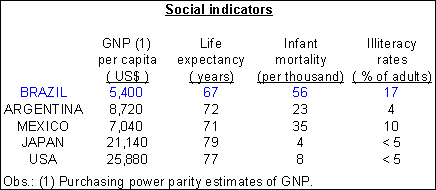
Source:World Development Report 1996.
This report begins by presenting the main tendencies and transformations of the Brazilian economy in the period following Word War II until the beginning of the 80s, highlighting the development plans which represented qualitative leaps in the country’s economic structure. These development plans were focused on a strategy of industrialization by import substitution and they are summarized in this first part, especially the Plano de Metas and the Second National Development Plan (II PND).
It then describes the period from the early 80s until 1992 marked by a prolonged crisis with alternate years of growth and recession, imbalance in the current account in the years 1980/85, and very high inflation rates. This period also revealed the exhaustion of the import substitution model. The government adopted "stop and go" policies and attempted to fight inflation through heterodox stabilization plans.
After the paper assesses the current situation and the recent economic stabilization plan, emphasizing the need for further macroeconomic stabilization in spite of the success of inflation rate control and the resumption of economic growth. Following a strengthening of public finances in 1994, during preparation for introduction of the Plano Real, the fiscal position, the net debt of the public sector and the current account deficit deteriorated in 1995 and 1996.
In its second part, the paper describes the main transformations in the world’s economy: the increasing globalization of the international economy, the emergence of growing markets among the developing countries of East Asia and Latin America, and the end of the Cold War.
Finally, this report evaluates Brazil’s possibilities of a successful participation in this new context, after a long period of crisis in which economic development issues remained a second priority. The question is: What are the requirements to achieve rapid and more equitable growth? The idea is to inquire as to what extent other development models (e.g., the success of many of the economies in East Asia) could or could not be applied in the Brazilian case, and, at the end, some indications for a new development plan are suggested.
I-THE COURSE OF THE BRAZILIAN ECONOMIC DEVELOPMENT
From the period post World War II to the 80s, as a result of the strategy of industrialization by import substitution, Brazil went through a process of profound transformations in its economic and social structures, changing from an essentially agrarian export economy to one containing an integrated industrial complex. Total GDP grew at an average annual rate of roughly 8% from 1948 to 1980. The following period from 1981 to 1992, marked by prolonged crisis and high inflation, grew only at an average annual rate of around 1%. In recent years from 1993 to 1996, when the economic growth was resumed, total GDP grew at an average annual rate of approximately 4% (see Figure 1).
Figure 1
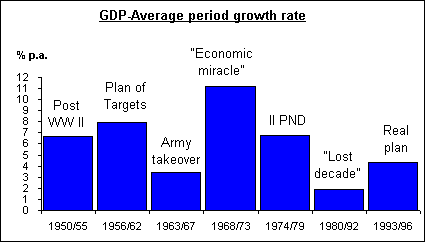
Source: IBGE
The industrial sector increased its share from 22% of GDP in 1939 to 44% in 1986. Due to the high-inflation that followed, industry’s share of GDP fell back to 37% in 1989, while the services sector’s share rose from 45% to 56% in 1989, led mainly by a significant increase in the share of financial institutions (from 8% of GDP in 1986 to 21% in 1989). In 1995, the proportionate shares of GDP were: agriculture 13.3%, industry 34.4% and services 52.3% (see Figure 2).
Figure 2
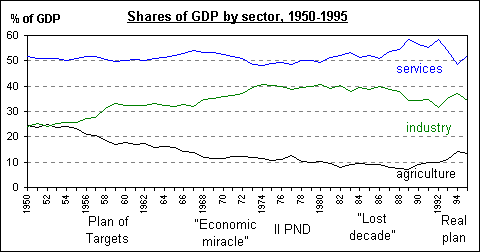
Source:IBGE
I.1 - The period 1950-1979 - Industrialization by import substitution
I.1.1 - 1950-1962 - The post World War II
The period 1950-1962 was fundamental for Brazilian industrialization. The dynamism of the import substitution model of industrialization, based on the protection of the domestic market, resulted in very high rates of economic growth. The average yearly growth rate in the period 1947-62 was over 6%; between 1956 and 1962, an economic boom took place impelled by the government’s "Plan of Targets"(Plano de Metas), the yearly growth rate averaged approximately 8% (see Figure 2).
The plan of targets (Plano de metas)
The day after President Juscelino Kubistschek inauguration a National Development Council was created, which formulated the Plan of Targets (Plano de Metas). This plan may be seen as the clearest manifestation of the import-substitution model(see Table 3).
Table 3

Source: Baer, Werner. 1995. "The Brazilian economy."
By means of economic policies and government investment, sectoral goals were financed and implemented, inducing the national/foreign private sectors towards strategic investments. A key role was acted by the government financial institutions (SUMOC-Currency and Credit Superintendency, BANCO DO BRASIL-Brazil Bank and BNDE-National Bank for Economic Development) through management of exchange rates, subsidies, fiscal incentives and financial assistance, favoring industrial development and protecting the rising industry.
However, it was not a global development plan. It did not include all areas of public investment or basic industries. Targets were supposed to be set for both government and private sector - the "tripé" (i.e.,the ownership structure among domestic private, multinational, and state firms) model. The state provided infrastructure and basic industries (e.g., Eletrobrás - the state-owned electric company; transports and basic industries, such as oil (Petrobrás), steel (Companhia Siderúrgica Nacional), iron ore mining (Companhia Vale do Rio Doce), and special metal alloys (Acesita)). Foreign investment was concentrated in the production of capital and durable consumer goods for the domestic market. Finally, domestic capital was engaged in complementary activities to those of foreign firms, such as non-durable goods, building industry, banking system, agriculture and mining.
Special programs were also established to promote such industries as automobile, ship building, and heavy machinery. These programs were organized through the development bank (BNDE) and they were directed by executive groups.
The most successful of these programs was the one designed to promote the automobile industry. It was directed by GEIA (Executive Group for the Automotive Industry). It offered special treatment for the importation of manufacturing equipment and automotive components for a limited number of years. In return, the firms committed themselves to a policy of progressive replacement of imports by components made in Brazil. As a result, the guidance provided by GEIA led to a rapid vertical integration of automotive production within the country.
Other executive groups made similar efforts in the creation of shipbuilding, heavy machinery, tractor, and telephone equipment industries, among others. The industrial base laid out in this period led in the late 60s to the highest growth rates of any other period.
In the early 1960s, however, Brazil faced foreign financing constraints as the import substitution had neglected promotion and diversification of exports while the requirements for interest and amortization payments, combined with profit remittances by foreign companies, produced increasing balance of payments difficulties. The economy lost its growth dynamism, and inflation rates increased to 80% p.a. in 1963.
I.1.2 - 1964-1967 - The Army takeover
After the army takeover in 1964, the military government launched a set of stabilization policies and structural reforms. The government by fiscal reform, cut expenditures and increased tax revenues. It also depressed wages (by deindexing wages from inflation rates) and adopted measures to develop and strengthen the financial markets (by indexation of bonds, capital and mortgage).
I.1.3 - 1968-1973 - "Economic miracle"
These profound institutional changes, the great influx of external financing and, specially, the existence of idle capacity in industry led to years of the highest economic growth (average annual growth was 11.2% in the period 1968-1973; see Figure 1) and low inflation by Brazilian standards (19% p.a. in average from 1968 to 1973). This period came to be known as the "Brazilian Miracle".
Industry was the leading sector, expanding at yearly rates of 12.6%. The government invested heavily in large-scale projects in electricity generation, transport systems, urban infrastructure, telecommunications and heavy industry.
I.1.4 - 1974-1979 - The National Development Plan II (II PND)
With the 1973 oil shock, 1974 Brazil’s total import bill doubled in comparison to 1973 import bill, resulting in a trade deficit of US$ 4.7 billion in 1974, in comparison to a balance in 1973, and an increase in the current account deficit from US$ 1.7 billion in 1973 to US$ 7.1 billion in 1974. Rather than promoting an adjustment through recession, the government chose to maintain the growth strategy, financing the imbalance with an increase in short-term foreign indebtedness.
As growth strategy, the National Development Plan II (II PND) was responsible for maintaining the tendency growth, although at lower rates. The GDP and industrial growth rates fell by almost fifty percent - 7.1% and 7.6% respectively - compared to the 11.2% and 12.6% registered during the 1967-73 period (see Figure 1). However, the foreign debt escalated from US$ 12.6 billion in 1973 to US$ 49.9 billion in 1979.
The National Development Plan II (II PND)
The investment program proposed by the National Development Plan II (II PND) was designed as a response to the world’s recession provoked by the oil crisis. It foresaw a program of substantial investments geared to the development of infrastructure (hydro and nuclear power, alcohol production, transportation, and communications), basic industrial outputs (such as steel, aluminum, cooper, fertilizers, and petrochemicals) and capital goods industries aimed at reducing external dependence.
Many of these investments were undertaken by state enterprises, whereas others (especially capital goods) were carried out by the private sector, with massive financial support from the development bank (BNDE). Special attention was given to the need to integrate the domestic market through regional development policies and implementing the industrial growth poles (petrochemical, steel and paper/cellulose).
The II PND was able to meet its goals for import-substitution of intermediate goods (see Table 4), stimulating the industrial producers of capital goods and the durable consumer goods industry acquired competitiveness in the international market.
Table 4
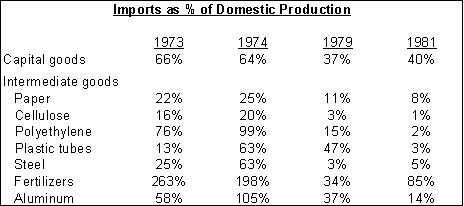
Source: Baer, Werner. 1995. "The Brazilian economy."
In fact, from 1974 to 1979 the country developed significant capabilities in the production of oil, electricity, transportation and communication networks. The II PND represented an intensification and diversification of the existing industrial structure, technological leaps and a more profound internationalization of the Brazilian economy.
I.2 - The Decade of the 1980s and the Early 1990s - "Lost Decade"
The period from the early 80s until 1992 revealed the exhaustion of the import-substitution model of industrialization which, during the previous forty years, had contributed to the emergence of an enormous industrial complex. It was marked by a prolonged crisis with alternate years of growth and recession, imbalance in the current account in the years 1980/85, including the 1982 foreign debt moratorium. Inflation rates, especially in late 1990s, reached levels never previously imagined. The government adopted "stop and go" policies and attempted to fight inflation through heterodox stabilization plans.
The dimension of the crisis is revealed by the more than 10% drop in GDP per capita between 1980-1992. The GDP growth in this period averaged just 1.9% p.a. in contrast to the 9% p.a. growth in period 1968-1979.
The crisis was aggravated by the financial collapse of the Brazilian State, hindering the State’s action even more and discouraging private investment. Another consequences of the State’s financial crisis were the breakdown of public health, educational and social security systems and the deterioration of transportation and telecommunication infrastructures, due to lack of public or private investments.
For all these reasons this period came to be called as the "Lost Decade".
I.2.1 - 1980-1985 - External imbalance
1979 witnessed the second oil shock, contributing to a further decline in terms of trade. At the same time, the sharp increase in international interest rates increased the cost of new borrowing and of the external debt service. The long delayed adjustment was finally introduced in the early 1980s: a tight monetary policy leading to recession, a maxi-devaluation of the currency, measure to encourage external lending to Brazil and cuts in state investments. This adjustment did not solve the country’s external debt constraint, and in 1982, following the Mexican moratorium, Brazil faced its own debt crisis.
Following the external debt crisis in 1982, the country adopted an IMF-style adjustment program in 1983, and a sharp recession followed. Brazil benefited from the expansion of the world’s economy so that the use of existing idle capacity and the incentives for exports resulted in growth in 1984 and 1985 with increasing trade surpluses.
The large trade surpluses favored the recovery of the current account, but there was a drastic decline in capital formation, from 21.6% of GDP in 1981 to 16.4 in 1985.
A side effect was the increase in inflation rates, credited to a mix of supply shocks, maxidevaluations in 1979 and 1983, and lack of fiscal discipline. These effects were magnified by the widespread financial indexation, a crawling-peg exchange rate, and generalized indexation of wages. As a result inflation rose from 110% p.a. in 1980 to 235% p.a. in 1985 (see Figure 3).
Figure 3
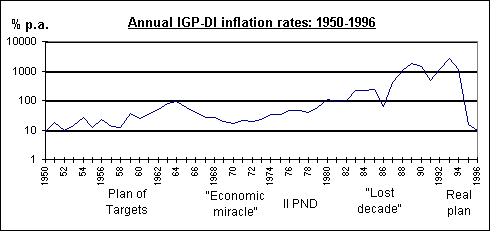
Source: FGV
I.2.2 - 1986-1992 - Stabilization plans era
1986-1989 - Cruzado, Bresser and Summer plans
Between 1985 and 1989, control of inflation was the most pursued economic target in macroeconomic policy, as indicated by the three stabilization plans (Cruzado Plan, Bresser Plan and Summer Plan) implemented in this period. The stabilization plans was characterized by "non-orthodox" attempts to fight inflation through price freezes without jeopardizing growth and all failed, mainly due to poor fiscal management and to distortions generated by the price control component introduced in the system.
Although volatile, growth averaged 4.5% in 1985 through 1989, but inflation skyrocketed from 235% p.a. in 1985 to 1,783% in 1989, reaching 81.3% per month in March 1990.
1990-1992 - Collor I and II plans
In March 90, the new government adopted a radical stabilization plan (Collor Plan I), by controlling inflation by strong financial liquidity squeezing. This was accomplished by freezing access to more than 80% of total financial assets in the economy, as well as by implementing an economically liberal package of reforms. The package main components were fiscal tightening, launch of a privatization program, trade liberalization and normalization of the country’s relations with the international community.
Despite short time of low inflation, the radical stabilization plan did not prevent the return of high inflation rates, and was followed by a second and unsuccessful stabilization plan (Collor Plan II). The tight monetary and fiscal policies, together with frequent changes in economy policy resulted in an average negative growth of -1.8% p.a. in 1990 through 1992
I.3 - CURRENT SITUATION - Real Plan (Plano Real)
In December 1993 the new Brazilian government began an implementation of a stabilization plan (Plano Real) based on fiscal restraint and de-indexation of the economy which are some of the weakness of the previous stabilization plans. After the currency changeover, in July 1994, inflation was brought down from a monthly rate of about 49% in June to 1.5% in September (Table 5 gives the stabilization plans outcomes).
Table 5
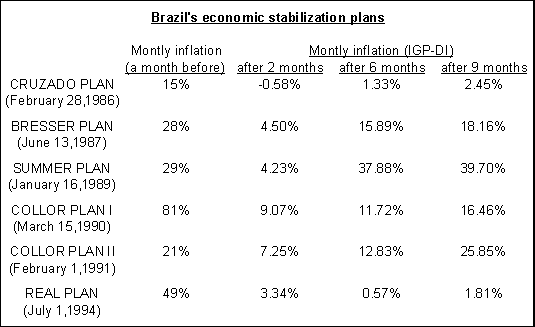
Source: FGV
The economic growth was resumed, mainly the industrial sector, and after many years of erratic trend, the GDP growth rates were 4.2% in 1993 and 6% in 1994 (see figure 1). After a brief downturn in early 1995, by end-May, Brazilian economy recovered from the effects of Mexico's exchange crisis: the GDP growth rates in 1995 and 1996 were 4.2% and 2.9%, respectively.
In spite of the success of inflation rate control and the economic growth since the launch of Plano Real, the fiscal and the current account in the balance of payments sides have been performing less satisfactory.
Following a strengthening of public finances in 1994, during preparation for introduction of the Plano Real, the fiscal position deteriorated in 1995 and 1996 due to an upsurge of spending at both the federal and state levels. As a result, the operational balance of the consolidated public sector worsened substantially, to a deficit of 4.8% of GDP in 1995 and 3.9% of GDP in 1996. The primary surplus of 5% of GDP in 1994 was reduced to less than 0.35% of GDP in 1995 and it was reversed to a primary deficit of 0.09% of GDP in 1996 (see Table 6).
Table 6
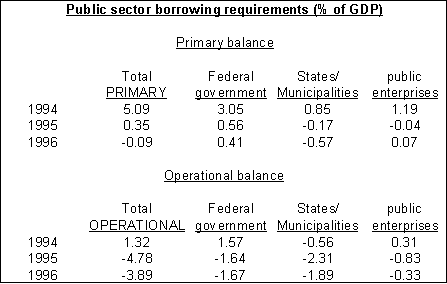
Source: Central Bank
At the same time the net debt of the public sector rose steadily in 1995 and 1996. In 1994 it represented 29.6% of GDP, the same ratio for 1995 and 1996 were 29.9% and 34.4%, respectively (see Table 6). The huge 1996 debt growth is explained by high real interest rates, sterilization of capital inflows, the impact of cleaning up the banks and restructuring state government debt.
Table 7

Source: Central Bank
Regarding the balance of payments (see Table 8), some observers have questioned whether the current account deficit, at its present level, can be financed through capital inflows. After a surplus of US$ 10.5 billion in 1994, the trade balance has shown a deterioration due to a substantial surge in imports at the end of 1994, which increased further in 1995 and 1996. Imports had increased as a consequence of trade liberalization and, after July 1994, as a result of the boom in the demand that followed the introduction of the Real. Constrained by the potential inflationary impact of a major devaluation, the government has chosen not to devalue. Instead, it addressed the weakening of the trade account with an increase in import duties on automobiles and durable products and measures in favor of further export growth (such as tax exemption for exports).
On the other hand, capital inflows and international reserves have been increasing. Total direct investment was US$ 2.2 billion in 1994; it reached to US$ 9.6 billion in 1996 or 39% of the current account. According to the information in the Bulletin of the Central Bank, the average maturity of the capital secured abroad is becoming longer: from 4.8 years average term in 1994, it had increased to 7.2 years in 1996. International reserves rose from US$ 38.8 in 1994 to US$ 60.1 billion in 1996 or 14 times of monthly imports. The impressive amounts of reserves as well as longer maturity of direct investment deny worried observers.
Table 8
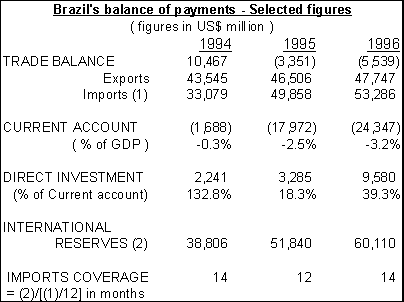
Source: Central Bank
II - INTERNATIONAL SCENARIO
Three recent changes have had a profound effect on the international economic environment: the increasing globalization of the international economy, the emergence of growing markets among the developing countries of East Asia and Latin America, and the end of the Cold War.
II .1 - Increased Globalization
The major change in the international economic environment is the increased globalization. National economies are becoming steadily more integrated. Technological barriers have fallen as transportation and communication costs have dropped, tariffs and nontariff barriers have been drastically reduced in a series of multilateral trade negotiations since World War II.
Trade has increased faster than output in the postwar era. In 1950, total world merchandise exports amounted to US$ 58 billion. By 1990 they had risen to over US$ 3.5 trillion, over 60 times as much. This rate of increase was roughly 3 times as fast as world output. This growth of trade has led to wider competition, allowing countries to benefit from their comparative advantage and raising living standards everywhere.
II.2 - Industrialization and growth come to the developing world
The second great change of recent years has been the rapid industrialization and economic growth of a number of developing countries in several parts of the world. The first of these emerging markets were the four Asian ``tigers'': Hong Kong, Singapore, South Korea, and Taiwan. Now Malaysia, Thailand, and some other Asian countries are following in their footsteps, and some of the Latin American countries, having overcome the debt crisis of the 1980s and undertaken economic and political reforms, have also begun to see faster, more sustained growth. This trend in Latin America was briefly interrupted by the late 1994 Mexico's exchange crisis, but in 1996 most of the region’s economy resumed growth.
The success of these countries, specially the Asian countries, offers valuable insights into the necessary ingredients for successful development. It has implications for Brazilian international economic policy and the rise of these countries also brings opportunities for Brazil. As a exporter of capital goods and of agricultural products, consumer goods, and commercial services, Brazil can be benefited from these economies' growing demand.
II.2.1 - The Success of East and Southeast Asia
From 1960 to 1993, 8 of the world's 10 fastest-growing economies were all in the same region: East and Southeast Asia. Japan and the four ``tigers'' (Hong Kong, Singapore, Korea and Taiwan) experienced growth in GDP per capita averaging over 6 percent per year. Malaysia's growth has averaged over 4 percent a year, and Indonesia's only slightly less. China has seen phenomenal growth in GDP per capita, averaging 8.1 percent per year since 1978.
Although their approaches to development have differed in various ways, the success of these economies teaches important lessons on the elements of a sound development strategy. These include attention to human and physical capital, a limited role for government, and export-oriented policies. Another lesson is that rapid development need not be accompanied by large income disparities.
The development of human capital has made a critical contribution to Asia's success. The region's successful economies have invested in nearly universal primary and secondary education, while at the same time developing their scientific and engineering capabilities. This has given them a labor force equipped to work with increasingly complex production processes, and has permitted them to move to increasingly sophisticated technologies over time.
Investment in physical capital has also contributed greatly. In the successful economies, most of this investment has been financed domestically, thanks to relatively high domestic saving rates. Some East Asian economies have achieved gross saving rates of more than 30 percent of GDP.
The role of government in many successful East Asian economies has generally been to maintain macroeconomic stability, avoiding extremes of high inflation and high unemployment. Deficits were small, and some governments actually ran surpluses. Government expenditure focused on investment, both in people and in infrastructure
The successful East Asian economies also adopted policies of outward orientation. Firms were expected to compete in export markets, where they would have to adopt international standards and best practices. Engagement in the international economy also facilitated the increase of technological capacity. Empirical evidence indicates that economies in East Asia and elsewhere that adopted such outward-oriented strategies enjoyed superior performance in terms of exports, overall growth, and employment. During the 1970s and 1980s, the more open economies in a large group of developing countries grew on average by 4.5 percent per year, compared with only 0.7 percent for more closed economies.
The East Asian experience upset the conventional wisdom on the relationship between growth and income equality. The established theories held that inequality was necessary to promote economic growth, because growth requires saving, and the wealthy tend to save more than the nonwealthy. Theory also held that inequality increased in the early stages of growth, as an income gap emerged between workers in the new industrial sector and those left behind in the traditional agrarian sector. The poor would eventually benefit from the growth in national prosperity, in this view. Confounding these theories, several East Asian economies succeeded in growing rapidly while not only maintaining a more even income distribution than many other countries but actually reducing inequality. More-equal distribution of income contributed to rapid growth through several channels. For instance, it facilitated the accumulation of human capital, as more households could afford to pay for their children's education. Land reform in Taiwan and some other economies after World War II both improved equality and enhanced peasants' incentives, stimulating growth.
II.2.2 - The Resurgence of Growth in Latin America
For many economies in Latin America the 1980s were a ``lost decade.'' After growing robustly in the 1960s and 1970s, these countries took on large foreign debts in the late 1970s and early 1980s. They pursued inward-oriented economic policies (import substitution strategy), developing their industries to supply domestic demand behind high trade barriers. These policies left them ill equipped to service this mounting debt. In 1981-82, high dollar interest rates pushed these countries' debt-service requirements upward, a deep recession in the United States lowered demand for their exports, and prices for their export commodities declined. Debt-service payments thus rose sharply in relation to export earnings. When these problems erupted into a crisis in Mexico in August 1982, a number of countries were forced to suspend these payments. Many were compelled to make adjustments to continue debt payments, while investors remained reluctant to extend new financing. Since late 1980s many Latin American countries have reformed their economies and have restructured their debts, and by the early 1990s most of these countries have resumed growth. Although late 1994 Mexico's exchange crisis affected severely region’s economy, most of the countries have recovered from the effects and have experienced growth of between 3% and 5% in 1996.
Latin American governments have started privatization programs, and they have adopted more outward-oriented policies. The star performer has been Chile, whose economy has seen growth averaging more than 6 percent per year since 1983. Other economies have also expanded. Argentina's economy, which contracted by 1 percent per year during the 1980s, has seen an even more striking recovery in the 1990s (over than 7% GDP average growth from 1991 to 1994, except for 1995 (- 4.6% GDP growth) due to Mexico’s crisis.
The reentry of a dynamic Latin America into the international economy offers especially great opportunities for Brazil to strengthen the position as a Latin America leader of the integration process in the world economy and have more effective participation in the great international debates and decisions.
II.3 - The end of the Cold War
In 1989 the Soviet Union relaxed its control over the Eastern European countries that had suffered its domination for over 40 years. Two years later the Soviet Union itself underwent a political and economical change, which quickly led to its breakup into 15 independent states. Most of these and the other formerly centrally planned economies are now, to varying degrees, engaged in a process of transition from central planning and state ownership to capitalism.
The Communist economies have been presenting poor performance since the 1980s. Managers of socialist enterprises lacked incentives to increase production or to innovate and, consequently, industrial productivity fell far behind the West.
The Communist countries also insulated themselves from the world economy and ignored the international trade opportunities. Trade was often undertaken merely for political reasons and mostly within the bloc (in 1989, for example, Czechoslovakia, despite its location adjacent to affluent Western Europe, conducted 54 percent of its trade with its fellow Communist countries, and almost 60 percent of that trade was with the Soviet Union).
III - SOME INDICATIONS FOR A BRAZILIAN ECONOMIC SUSTAINED GROWTH - A NEW DEVELOPMENT MODEL
The changes have created important opportunities for Brazil. Understanding these changes helps us see where the international economy is directed towards in the future, so that we can more effectively respond to these challenges and take advantage of these opportunities.
The present international context of global commerce and financial markets also requires the abandonment of the notion of self-sufficiency with the actual integration in the international economy-assumptions diametrically opposed to the import-substitution model, and which, also explain its obsolescence. Brazil’s gradual elimination of protectionist barriers in the early 90s indicates a new path for a successful integration into the world’s economy.
This new stage in world development in which economical blocs are being formed, capital assumes great mobility and is directed towards the production of goods/services if returns on investment are within international levels. Returns vary according to production costs, and also, on the comparative advantages of a given country.
According to the experience of the Asian tigers, the best illustration of a country’s comparative advantage is its educational base: a highly educated population is a clear indicator of high productivity and capacity to generate and absorb technical progress. In other words, advanced human capital means high productivity which is the only way to achieve sustained development and, better standard of living.
Therefore, the greatest priority to speed up the Brazil’s development in a new development model lies on providing for education and investments in social infrastructure ( health, housing, funding for research and development and workforce training).
The other requirements of a new development model are: first, the country must improve its capacity to export, and; second, and most important, Brazil must tackle the insufficiency in domestic savings by changing State intervention.
Exports have displayed a mediocre performance. Decades of import-substituting industrialization have not delivered significant new comparative advantages for Brazil. The country remains basically an exporter of goods intensive in natural resources and poorly qualified labor – namely primary, semi-processed and manufactured goods with low value-added content. Improvements in exports will depend on the adoption of new techniques of production, management and marketing as well as on substantial cost reductions, which in turn depend on infrastructure improvements and on the elimination of excessive bureaucratic obstacles and regulation.
Second, Brazil must increase its savings rate. Foreign capital is financing consumption to a large extent, including the government deficit, rather than financing investment. By saving more, the country would enlarge domestic funds available for investment and become less dependent upon foreign capital. The reduction in the public sector deficit plays a crucial role here, since excessive government current spending reduces investments. There has been no increase in the ratio of domestic savings to GDP, which remains at 17% – a small number, considering ratios on the order of 25-35% in the most successful emerging countries. Thus, the inescapable conclusion is that Brazil must increase its savings rate through administrative and social security system reforms.
In short the key question related to a new development model is the reform of the State. At present, Brazilian society recognizes that the great opportunities for State intervention to speed up the nation’s development lie on: a) assuring macroeconomic stability; b) providing social infrastructure, c) creating a modern, stable and transparent regulatory framework; d) establishing top quality physical infrastructure; and, e) exploiting to the maximum the partnership of the public sector (including state and municipal levels) with the private sector, and the ability and interest of the private sector in investing on infrastructure, taking advantage of the extension of privatization and the franchising of public services.
In other words, a successful new development model implies on reducing State intervention in the economy, while stimulating the private sector, through export oriented policies, to catch up with modern technology and increase productivity.